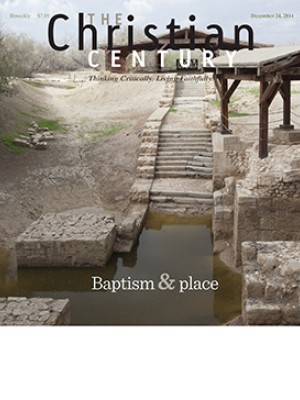Sunday, December 28, 2014: Luke 2:22-40
Luke’s first two chapters are a metaphorical retirement home for elders who are “looking forward to the consolation of Israel.”
When 73-year-old Morris Weiser reached up with his cane to tap the ceiling of the aging Chasam Sopher synagogue on Manhattan’s Lower East Side, a shower of decaying plaster fell onto the wooden pews below. “I’m scared that on Rosh Hashanah the ceiling will fall down and hurt someone,” Weiser told the New York Times.
That was almost 30 years ago, and Weiser, a retired butcher, had already been working for four decades to save the declining synagogue. He lost seven brothers and four sisters during World War II and was one of only 200 Jews to survive the terrors of the Janowska concentration camp in Poland, where at least 40,000 people were killed. After the war, Weiser came to New York and almost immediately began worshiping at Chasam Sopher.
Read our latest issue or browse back issues.
By the late 1980s, though, the neighborhood had deteriorated, the synagogue had no rabbi, many of the members had moved elsewhere, and it was a struggle even to gather a minyan for services. Weiser himself was in declining health, his stomach damaged by his ordeal in the prison camp. “I’m broken down like this shul,” he said. Nevertheless, Weiser believed that God had saved him from Hitler in order that he might save this synagogue as a place of worship. One day, he said, gazing with hope into God’s future, “there’ll be a lot of Jews here.”
Morris Weiser could well have been a character in the first two chapters of the Gospel of Luke. This swath of the book is a metaphorical retirement home for elderly Jews who, like Morris Weiser, are “looking forward to the consolation of Israel.” There is Zechariah, a priest at the temple, and his wife Elizabeth, both of whom have lived righteous and blameless lives, despite the bitter disappointment of childlessness. They are, Luke says delicately, “getting on in years.” There is devout Simeon, old enough to be contemplating his own death, looking expectantly every day for the appearance of the Messiah. And there is Anna, in her eighties, fasting and praying night and day in the temple, searching for a sign that God will redeem Jerusalem.
And then, in a sudden swirl of events, God gathers these aging people into the drama of salvation. “By the tender mercy of God,” Zechariah will later sing, “the dawn from on high broke upon us.” Astonishingly, Zechariah and Elizabeth have a child, a son named John who will become a preacher of repentance and baptism and, even more important, will bear witness to the One who will baptize with the Spirit and fire. Simeon, who has been spending his time gazing at the actuarial charts of his own mortality, amazingly finds himself in the temple gazing instead into the face of the Christ Child. “My eyes have seen your salvation!” he cries. Anna, always hanging around the temple, watches the whole thing and then races all over town excitedly giving the news of this child to all who were “looking for the redemption of Jerusalem.”
And then these four senior citizens, having sung their songs and spoken their lines, disappear from Luke. It’s strange. It is almost as if, having seen the news reports of God’s coming salvation in Jesus, they get up, turn off the television, go to bed, and leave the rest of the story to twenty- and thirtysomethings. And they depart not because they are weary but because they are all full of hope in God’s providence—and therefore able to trust the future to God.
Zechariah, Elizabeth, Simeon, and Anna have a faith that leans forward into the promises of God, even when they have no idea how those promises will be fulfilled. Readers of Luke will discover soon enough that everything these four saints hope for is indeed accomplished—Israel is consoled, the gentiles are given light, and a mighty savior is raised up in a blaze of Easter glory.
In my city there is a congregation whose gifted and faithful pastor had formal charges filed against him by denominational officials because he was in a committed same-sex partnership. The congregation stood firmly with its pastor, and a groundswell of support for him emerged across their denomination. Several years of judicial process and discernment over this case eventually led that denomination to change its policies and to take a more gracious and just position toward gay and lesbian clergy and members.
Several months ago I attended a meeting at this church. I noticed on the walls several photographs of the sort that hang in many churches: buildings, pastors, Sunday school classes from days gone by. In one black-and-white photo—taken, I would guess, in the late 1940s—the congregation is gathered in the churchyard. There they are, in their loosely hanging suits and church dresses, some of them wearing the heavy-framed eyeglasses of the day. They have no doubt just been in worship, praying that God will bring justice and peace to the world.
As they looked into the camera so long ago, they had no idea, of course, that years later it would be their own congregation that God would use to bring some of that justice and peace to the world. They were simply—like Zechariah, Elizabeth, Simeon, and Anna—leaning forward by faith into the promises of God.
As for Chasam Sopher, in the last few years the building has been beautifully renovated. Their rabbi leads services every day, and they no longer worry about gathering a quorum. It is known in the neighborhood as “the shul where everyone is welcome.” Morris Weiser’s son, Eugene, now serves as synagogue president. There are indeed “a lot of Jews there” now—just as his father predicted, leaning forward into the promises of God.






